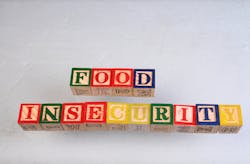A survey conducted by the New York Health Foundation puts a spotlight on the many ways that food insecurity and poor healthcare are interconnected.
The New York Health Foundation is a private, statewide foundation dedicated to improving the health of all New Yorkers. Its new report details the results of a 1,507-person statewide survey that elucidates many of the reasons why obtaining and preparing food can be difficult, and the tradeoffs that individuals make to put meals on the table. The report notes that a 2019 study estimated that in New York State, the annual healthcare costs associated with food insecurity top $3.4 billion, or approximately $173 per person. Prior to the COVID-19 pandemic, one in 10 New Yorkers—nearly two million people—were food-insecure.
This report goes beyond identifying the number of people facing food insecurity. It surveys them on the challenges around getting and preparing meals, and how it relates to their health. Twenty-one percent of surveyed people identified as food-insecure say they delay or skip medical care, and 13 percent delay or do not purchase prescription medication. For chronically ill food-insecure individuals, these rates are even higher. Twenty-three percent of such individuals—individuals more likely to need medical care and medicine— delay or skip medical care, and 16 percent delay or simply do not buy prescription medicine.
Approximately two-thirds of food-insecure individuals report that it is “extremely” or “somewhat” difficult to afford food. For a majority of food-insecure individuals, transportation is, at least sometimes, a barrier to getting the food they need. Approximately half of food-insecure individuals eat less to stretch the food that they can afford.
Among food-insecure New Yorkers, one quarter (28 percent) did not participate in any emergency or food benefits program such as the Supplemental Nutrition Assistance Program (SNAP) or the Special Supplemental Nutrition Program for Women, Infants, and Children (WIC) in the last 12 months. Individuals who do participate in food benefits programs rate these programs highly. Eighty-nine percent of SNAP participants and 87 percent of WIC participants agree that the benefits are easy to use. Eighty-seven percent of families that participated in school meals in the last 12 months agree that the meals are helpful.
In terms of recommendations, the report suggests that policymakers can work to maximize participation in SNAP and WIC. “Targeting outreach, easing application and recertification burdens on eligible participants, and covering the costs of online grocery delivery could not only lower food insecurity rates but also decrease health care expenditures for the state,” the report said. “For families with children, policymakers can work to permanently extend universal school meals statewide and provide cash benefits like P-EBT [Pandemic Electronic Benefit Transfer] over the summer.”
The report also recommends that healthcare providers implement food insecurity screening and referral processes. They can also support “Food Is Medicine” interventions, such as medically tailored meals. Advocating for Food Is Medicine programs to be eligible for Medicaid reimbursement could ultimately help connect people to the healthy food they need to thrive.


